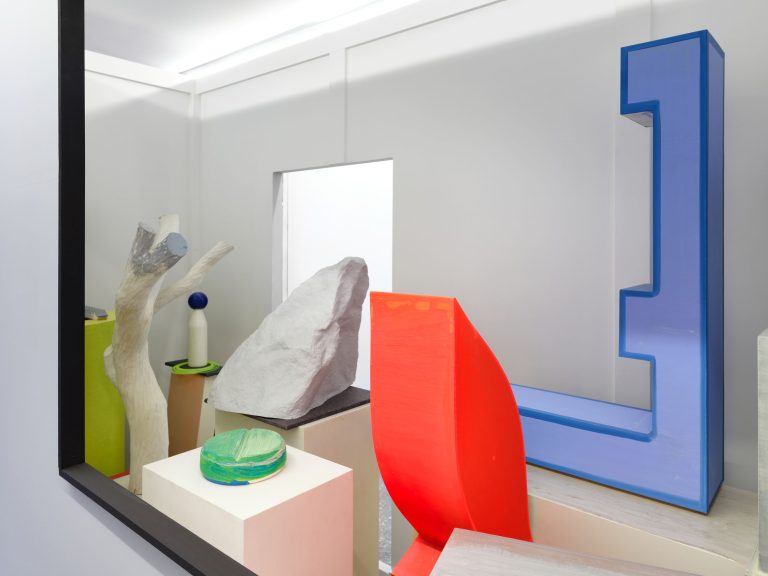Artist: Batsheva Ross
Exhibition title: Fitness Studies
Venue: Kantine, Brussels, Belgium
Date: January 30 – March 14, 2021
Photography: all images copyright and courtesy of the artists and Kantine, Brussels
In The Placement of the Thigh by Batsheva Ross (2020) a yoga instructor sits in the centre of a fitness studio. Her lycra-covered legs, resting against the floor, are open at a ninety-degree angle towards the viewer: star-like, these limbs direct us along the surface of a sloping wooden floor. The instructor’s V-shaped leg form is echoed by some of her students, who attempt to imitate her. There are Vs that flop or spring, that shift off-kilter, that stretch elastically off the canvas or collapse into a pile of brushstrokes.
Rounded figures lie with their legs open in a similar V-form in The Land of Cockaigne by Pieter Bruegel the Elder (1567). The setting is a hill, budding with cooked food. The figures have been exercising their stomachs with a feast of sausages which grow on trees and loaves of bread that bloom like cactus. One figure’s fanned-out form emphatically delineates the bloat of the hill. He stares flatly at the sky: shavasana, corpse pose. T.J. Clark says, “Painting…seems to be best fitted to show how much of human culture and nature derives from uprightness – anatomical high standing – which the ground supports but at the same time qualifies.”
Ground as gravity, and as canvas, creates the conditions for a bipedal figurative painting tradition. How humans react to ground is both physics and ethics: upstanding, upstage, downfall, downtrodden. Alternatively, a figure can embrace the horizontal axis (count the muscles that touch the floor). In painting space, the illusion of ground (or floor) is achieved through the pictorial convention of three-point perspective; a broken parallelogram that explodes out of the painting. The motion of the scene is captured in a flickering, frozen moment. “Stasis in Greek originally meant ‘standing’. The stadium was where well-adjusted bipedal bodies strove to remain upright while others fell down.”*
Within the exhibition space of Fitness Studies, the paintings’ broken perspectives stretch and join together into a stadium or an anatomy theatre. The paintings are socialised into a group where an instructor is always present. They position us: where we look and how we move.
Instruction is often present in Degas’ 1870s studies of ballet dancers rehearsing. Dance students are arranged in clusters around an instructor, the negative space of a vast, sloping wooden floor creating contrast. Some follow the instruction with oblique, flung-out limbs whilst others yawn, stretch, or chat with each other. Like other Impressionists, Degas pictured a social phenomenon at the interstices between work and free time. The subjects are working girls rehearsing towards a job entertaining the bourgeoning middle class. Studies of group activity awkwardly situated at the boundary of work and free-time ask: What are the desires that drive such a social composition and can they be realised? What does the work of learning look like? And when does work stop?
The Anatomy Lesson of Dr. Nicolaes Tulp by Rembrandt (1632) shows a group of medical students closely observing their instructor, who is explaining the intricacies of a human cadaver. The corpse lies not on the ground, but on a wooden table surrounded by the group, with its left arm flayed open. Labour is embedded within the ligaments and muscles, now exposed. The teacher gestures with his free hand to make a point.
“Eternity means the mad wish for stasis – for final fulfilment and perfection – that is constantly present in workaday life, haunting it, making it bearable.”*
*T.J. Clark, Heaven on Earth: Painting and the Life to Come (2018)

















